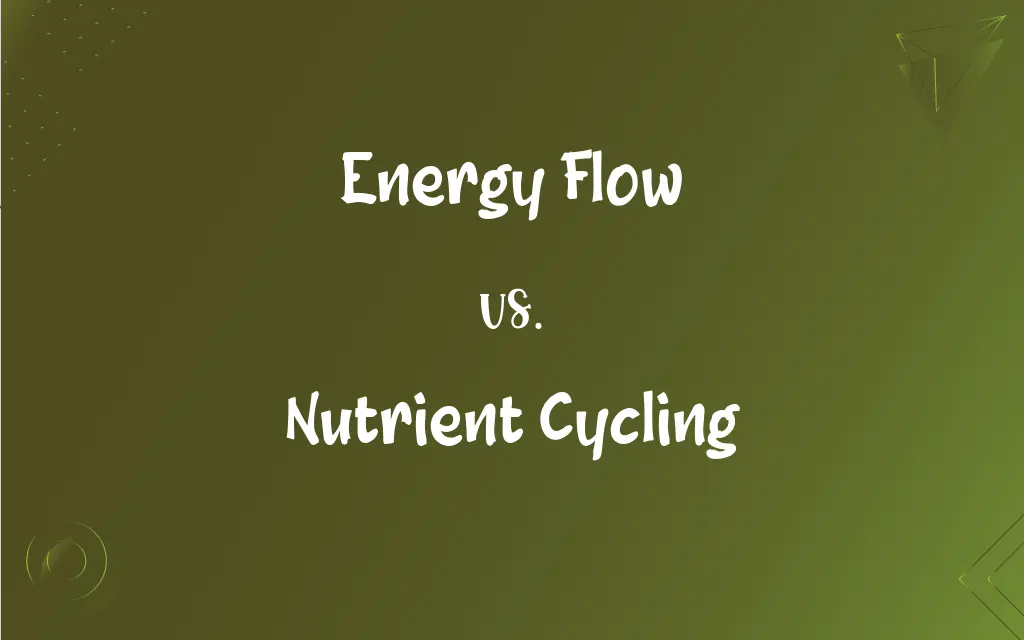Energy Flow vs. Nutrient Cycling: What's the Difference?
Edited by Aimie Carlson || By Harlon Moss || Updated on October 12, 2023
Energy flow refers to the linear transfer of energy through a food chain, while nutrient cycling involves the reuse and recycling of nutrients within an ecosystem.

Key Differences
Energy flow delineates the movement of energy from one organism to another within an ecosystem, typically via consumption. Nutrient cycling, on the other hand, is characterized by the perpetual movement and recycling of nutrients like carbon, nitrogen, and phosphorous within the ecosystem, ensuring that these vital elements are continually available to organisms. The divergent point lies in the fact that energy flow is unidirectional (from the sun to producers to consumers), whereas nutrient cycling operates in a closed loop.
To illustrate, energy flow begins with the absorption of solar energy by producers, namely plants, which is then transferred to consumers through the food chain, inevitably lost as heat at each trophic level. Nutrient cycling, in contrast, engages in a continuous loop, where elements are utilized by organisms and subsequently returned to the ecosystem via decomposition, ensuring sustainability and balance within the natural world. The pattern of energy flow has a distinct start and endpoint, while nutrient cycling does not.
In considering energy flow, the sun fuels the primary producers which are then consumed by primary consumers, and so on, with energy being lost as heat with each transition, obeying the second law of thermodynamics. In contrast, nutrient cycling is an enduring, iterative process, wherein nutrients are repeatedly utilized and reintroduced into the ecosystem, facilitating sustained life and development throughout multiple generations. Consequently, energy flow and nutrient cycling diverge in their patterns of transfer and utility in an ecosystem.
Reflecting on the concept of energy flow, it is essential to understand that it illuminates the path of energy from the sun through various trophic levels, accentuating the intrinsic loss at every stage. Oppositely, nutrient cycling perpetuates the stability and sustainability of ecosystems by continuously recycling essential elements, preventing their depletion and ensuring consistent availability to all organisms. The very essence of life and sustenance in an ecosystem is underpinned by both energy flow and nutrient cycling, despite their distinct mechanisms.
When we observe energy flow and nutrient cycling in synergy, it becomes palpable that they are the foundational mechanisms underpinning ecosystems, albeit through discrete methods. Energy flow furnishes organisms with the requisite power to perform life-sustaining activities, albeit with a clear and finite path of transmission. Nutrient cycling, conversely, secures the perpetual availability of essential minerals and elements, safeguarding the long-term viability and balance of the ecosystem and its inhabitants.
ADVERTISEMENT
Comparison Chart
Direction
Unidirectional (linear)
Circular (recycling)
Principle Elements Involved
Energy (typically sunlight)
Nutrients (such as carbon, nitrogen)
Trophic Level Interaction
Energy is transferred and diminished at each trophic level
Nutrients are reused at each trophic level
End Result
Energy is eventually lost as heat
Nutrients are continually recycled
Role in Ecosystem Sustainability
Provides the energy needed for life processes
Ensures availability of vital nutrients for life processes
ADVERTISEMENT
Energy Flow and Nutrient Cycling Definitions
Energy Flow
Energy flow can never be a closed loop as energy is invariably lost at each stage.
In ecosystems, energy flow illustrates how energy dissipates at each level, eventually lost as heat.
Nutrient Cycling
Nutrient cycling entails the continual circulation of essential nutrients through an ecosystem.
Nutrient cycling ensures the consistent availability of phosphorous in lake ecosystems.
Energy Flow
Energy flow is characterized by the linear transfer of energy from producers to consumers.
The energy flow in the forest starts from trees and progresses to herbivores and predators.
Nutrient Cycling
Nutrient cycling maintains ecosystem stability by recycling vital elements like nitrogen and carbon.
Nutrient cycling in forests involves the decomposition of fallen leaves, returning vital elements to the soil.
Energy Flow
Energy flow denotes the unidirectional movement of energy through an ecosystem’s trophic levels.
In the ocean, energy flow moves from phytoplankton to the fish that consume them.
Nutrient Cycling
Nutrient cycling incorporates processes like decomposition to reintroduce nutrients back into the ecosystem.
The nutrient cycling in grasslands ensures that the nutrients from decaying organisms are reintegrated into the soil.
Energy Flow
In energy flow, energy is progressively lost as heat at each subsequent trophic level.
As energy flow progresses through the food chain, less energy is available at higher trophic levels.
Nutrient Cycling
Nutrient cycling involves the absorption, utilization, and subsequent release of nutrients within an ecosystem.
Through nutrient cycling, decomposed plant matter enriches the soil, promoting further plant growth.
Energy Flow
Energy flow highlights the passage of energy from sunlight to producers and then to consumers.
In the savanna, energy flow initiates with the grasses and moves towards the herbivores and predators.
Nutrient Cycling
Nutrient cycling facilitates the perpetual use and reuse of nutrients across all organisms and environments.
Nutrient cycling in the ocean supports marine life by recycling minerals through various trophic levels.
FAQs
What is the basic principle of energy flow?
Energy flow describes the one-way passage of energy through an ecosystem’s trophic levels.
Can nutrient cycling occur in various ecosystems?
Yes, nutrient cycling occurs in all ecosystems, ensuring the continual availability of essential nutrients.
Why is energy flow considered unidirectional?
Energy flow is unidirectional because energy, once used, is lost as heat and cannot be recycled in the ecosystem.
How does energy flow affect ecosystem structure?
Energy flow determines trophic levels and influences population sizes and structures within an ecosystem.
What roles do decomposers play in nutrient cycling?
Decomposers break down organic matter, returning nutrients to the ecosystem, crucial for nutrient cycling.
What is the significance of primary producers in energy flow?
Primary producers initiate energy flow, converting solar energy into a form consumable by other organisms.
How does nutrient cycling ensure ecosystem stability?
Nutrient cycling continuously recycles vital nutrients, maintaining their availability and balance in ecosystems.
Does energy flow influence biodiversity?
Yes, energy flow influences trophic structures, which can impact species diversity and abundance.
Can energy flow impact an ecosystem’s productivity?
Absolutely, energy flow determines available energy, influencing productivity and biomass across trophic levels.
How does energy flow begin in most ecosystems?
Energy flow usually begins with the sun, as primary producers convert solar energy into usable forms.
Is the loss of energy in energy flow significant?
Yes, significant energy is lost at each trophic level, often as heat, making higher levels less energy-dense.
How does nutrient cycling affect soil quality?
Nutrient cycling enhances soil quality by reintegrating nutrients from decomposed organisms, supporting new growth.
Is human activity impacting nutrient cycling?
Yes, activities like agriculture and pollution can disrupt nutrient cycling, impacting ecosystem health.
How is nutrient cycling related to ecological balance?
Nutrient cycling sustains ecological balance by ensuring consistent nutrient availability, supporting stable populations and interactions.
How does energy flow relate to food webs?
Energy flow illuminates the path of energy transfer through the various interconnected feeding relationships in food webs.
How does nutrient cycling affect organism health?
Nutrient cycling ensures organisms have continuous access to vital nutrients, supporting growth, reproduction, and overall health.
Can nutrient cycling be disrupted?
Yes, factors like deforestation or pollution can disrupt nutrient cycling, potentially affecting ecosystem balance.
Why is energy flow crucial for sustaining life?
Energy flow provides the necessary energy for all organisms to perform vital life processes.
Which nutrients are commonly involved in nutrient cycling?
Nutrients like carbon, nitrogen, and phosphorous are central to nutrient cycling in ecosystems.
What is the relationship between nutrient cycling and biogeochemical cycles?
Nutrient cycling is a subset of biogeochemical cycles, focusing on the continuous recycling of nutrients in ecosystems.
About Author
Written by
Harlon MossHarlon is a seasoned quality moderator and accomplished content writer for Difference Wiki. An alumnus of the prestigious University of California, he earned his degree in Computer Science. Leveraging his academic background, Harlon brings a meticulous and informed perspective to his work, ensuring content accuracy and excellence.
Edited by
Aimie CarlsonAimie Carlson, holding a master's degree in English literature, is a fervent English language enthusiast. She lends her writing talents to Difference Wiki, a prominent website that specializes in comparisons, offering readers insightful analyses that both captivate and inform.
































































